8. The Open Group Presentation
An Invitation to Present at The Open Group
As Kathleen tries to leave the office, a call comes in. She hesitates as she doesn’t recognize the number, but then reluctantly answers it.
At that hour of the evening in the US, she is surprised to hear a man with a British accent on the other end of the phone. It is none other than Steve Nunn, President and CEO of The Open Group. Kathleen had met him at a conference she had attended about a year ago. At the time, Steve had seemed very interested in the fact that ArchiSurance was using several of The Open Group standards together to help in its Digital Transformation.
After a few pleasantries, Steve got right to the point. “Kathleen, I’m calling to see how things are going with your Digital Transformation at ArchiSurance. But the real reason for my call is to personally invite you to be a plenary speaker at our upcoming event. Would you be interested and available to accept?”
Kathleen is flattered. “Thank you, Steve. I accept!”
“Great, I’m so glad you will join us! Thank you. I know our event attendees will be very interested in your case study and the outcomes you have achieved from using The Open Group standards together. You may not know it, but part of the charter for our events is to provide opportunities for members and the public to learn from the experience of other members. As you’ve already experienced, at all our events we host formal presentations in our plenary and track sessions, plus informal networking opportunities over meals and happy hours to facilitate learning through personal connections. I hope you can stay after your presentation is over and participate in all of it.”
“Yes, OK Steve, I will plan on that. And – to answer your other question from earlier – our Digital Transformation is going really well. In fact, you’ll be happy to hear that I would attribute a large portion of that success to our decision to use The Open Group standards.”
“That’s wonderful to hear, Kathleen!”
“Actually, Steve, this might be a good opportunity for me to ask you for something.”
“At your service. How can I help?”
“Well, there are several members and staff at The Open Group that I’d like to meet and thank personally for their contributions to our success. Would you help me to get in touch with them?”
“Of course, I’d be pleased to make introductions for you! Who in particular would you like to meet?”
“Well, we’ve been really helped in our transformation work by several of The Open Group publications. So, it would be great to meet some of your member authors. For example, we read The Open Group Guide to Tool Rationalization using the IT4IT Reference Architecture Standard [26] and followed its clear step-by-step “how to” guidance to rationalize our own toolset here at ArchiSurance. That document saved us so much time and money that we were then able to free up budget for use on more strategic initiatives. We also used concepts from another IT4IT Forum White Paper called Why Business and IT Must Co-Create Strategy for a Digital Enterprise [27]. We adopted the vision in that paper which led us to mature our targets for our “to be” state. That’s part of what helped us leapfrog ahead in how we construct and execute our strategy for digital products today.”
“Oh sure, I’d be happy to introduce you, Kathleen. Many of those authors are our most active contributors and they attend several of our quarterly events every year. It shouldn’t be too hard for me to track them down.”
“Thank you, Steve. And I’d also like to meet the leaders of the IT4IT Forum and the Architecture Forum; a couple of members of my team have been actively participating in Forum work groups that are driving the next versions of your architecture-based standards.”
“Oh, that goes without saying. Did you know that all our Forums are led by members like you who are elected as Forum officers by their member peers? Even without my help, once you’re at our event, you’ll find that our staff Forum Directors and our Member Chairs always reach out proactively to welcome new participants.”
“Well, that’s great because I’d also love to meet the authors and leaders of another one of your standards: the DPBoK Standard was timely for us because it became our handbook for Digital Transformation. It kept us on track with the really important part: our people and investing in their skills development.”
“Oh, I’m so glad you took advantage of the fact that we have ongoing special projects like the DPBoK Standard. That’s an example of one of our cross-Forum projects which we open to all members to both learn from and contribute to, with real-world, pragmatic experience. They’ll be pleased to meet you in person.”
“I really do need to go; a family dinner awaits. But if I could share just one last thought with you? Here at ArchiSurance, we keep finding more and more ways to participate and gain benefits for our whole division by being more active in The Open Group Forums. The more we’ve investigated and got involved, the bigger our return has been. Now, we are one of the companies helping to determine the direction of the next versions of a few of your standards. So, at this point, I guess you might call us a “key influencer” – we’ve hit the big time, ha ha!”
“Well, it’s great to hear about your journey so far with the Forum, Kathleen. I’ll look forward to seeing you on our plenary stage next quarter and until then, enjoy that journey – and your dinner, too! Cheers! And bye for now.”
Kathleen smiles, hangs up the phone. She grabs her keys and laptop bag, and heads out the door. On the drive home she thinks more about her journey with The Open Group.
She had originally found out about The Open Group when the Strategy and Architecture group started using the TOGAF Standard. ArchiSurance became a member of The Open Group when a group of architects was going through TOGAF Training and Certification. Subsequently, she found out about the IT4IT Standard and simply downloaded it for free from The Open Group website. After a cursory read, she had realized how much it could help accelerate the team in their solutioning for current initiatives and challenges. It was such a small start, she mused, but look at what a positive impact becoming members has had on our organization.
She thought about all the professional growth her own peers like Terri had experienced as a result of their growing engagement in the Forum. Several had gone from just joining and listening to Forum work group virtual sessions, to later becoming work group leaders and even proposing hot topics and launching their own Forum work groups. Even better, several of her colleagues were now primary authors on thought leadership and “how to” publications for the industry, or elected officers of one of the Forums, which then led to speaking engagements and video recordings at the live events.
As she pulls into the driveway after a long but satisfying day at work, Kathleen remembers back to when ArchiSurance had cast their “one vote per organization” in their first Forum “ballot” as new members of The Open Group. She contrasts that to last month when she and her colleagues had watched the work group come to consensus on accepting the final version of an entire chapter of the standard that her team had drafted and submitted for review for the next version. The next time ArchiSurance cast their ballot, it will be to vote in the Company Review for a standard they had helped to write. What a great thing to be able to say!
We helped to build an industry open standard, she thinks, that is available free for anyone to use to improve their digital product delivery. That’s pretty darn cool. The car door clicks shut behind her and she walks toward the warm glow of the porch light and her family waiting for her inside.
Kathleen’s Presentation
Several months later, Kathleen approaches the registration desk of The Open Group event. She introduces herself as a plenary speaker and asks to be connected to Steve Nunn. Taking the time to enjoy breakfast and a cup of coffee, she is pleased at how friendly the other registered attendees are as a few of them walk up and introduce themselves and engage her in conversation near the coffee station. By the time she is ready to enter the plenary ballroom, she has a sense of camaraderie and feels less nervous about who might be in the audience and whether her presentation topic will be of interest to them.
Shortly, Steve Nunn calls Kathleen to the stage. “And now I have a special treat for you,” he addresses the audience. “Many of you tell me that you like our Case Study presentations best. You know, the ones delivered by people who don’t just talk the talk but have also had to walk the walk – sometimes walking across fire?”
The audience laughs, based on shared experience.
“And many of you have also shared with me that Digital Transformation and digital product delivery is what is most on the minds of your organization’s leaders this year. Well, Dr. Kathleen Stone, Chief Architect with ArchiSurance, is going to give you the story of their Digital Transformation. I was so impressed by all that the company ArchiSurance has accomplished, that I invited Dr. Stone here to share with you her real-world story of how they kicked off a Digital Customer Intimacy initiative a little over a year ago. She’ll share a bit about the how, and then what outcomes they have achieved so far. And, finally, in a topic near and dear to my own heart, she will also share with you how The Open Group portfolio of open digital standards helped strengthen and accelerate their Digital Transformation.”
Stretching out his arm toward Kathleen, Steve says, “So now, would you please give a big warm welcome from The Open Group to Kathleen.”
As the applause dies down, Kathleen walks out from behind the podium, and stands in the middle of the stage to begin her presentation to The Open Group. She directly addresses the whole audience using the same “Imagine” slide she used in her ArchiSurance kickoff meeting to her own leadership. This sets the scene as she begins to tell the story of the Digital Transformation journey ArchiSurance has been on for over a year.
“We’d just been through a merger of three companies into one. After all the streamlining of processes and the rationalization of systems that was done during the merger, we felt we’d made some good strides toward becoming an Agile organization. However, analysis showed we hadn’t really gone beyond the implementation of Agile in development, or as Amy Lee, the external consultant we hired indicated, we only implemented Agile ceremonies! It wasn’t really Dev and Ops, let alone being transformed to a Digital Organization! In fact, instead of being Agile, we started to lose a grip on the budget. So, being honest with ourselves, we recognized we hadn’t changed much more than the introduction of scrumming as a way to develop software, and we had kept everything else pretty much the same as before. It was time to transform the whole organization, and get our core operational value streams in order, with cross-functional teams that work together.”
Kathleen steps back and turns slightly to look up at the screen. “I will never forget this town hall meeting, I really felt we were turning the company around. I had the honor to present our ideas to get everybody on board. I knew I still had to convince some who were cynical about change. And others who thought they might lose the empires they had built! I got on the stage and asked everyone to close their eyes, to imagine …” She pauses, and takes a moment to look at the audience.
"Well," she smiles, feeling a real sense of pride. "We don’t have to imagine anymore. At ArchiSurance, we are a digital enterprise. Our organizational structure consists of teams of teams that work across key operational value streams with everyone working on common goals and outcomes. Our budgets are aligned to the value streams, helping us to make good investment choices holistically instead of in our functional silos. In fact, our silos have been broken down so much that redundancy and duplication in our environments is almost non-existent. We are Agile in our digital product development, from Ideation and Strategy, through Development and Operations. Best of all is that our customers are happy. We no longer get the complaints about being transferred from department to department that we used to get. Now we hear from our customers that they are happy with our service and they get an immediate response and help. We also have the people, processes, and technology in place for continuous shared customer insights. In other words we are in touch and in tune with our customers. We did this by using an outside-in approach, with our customer being the key stakeholder.”
Kathleen moves on to The Open Group Architecture Standards. “As you can see, we really owe a large part of our success to The Open Group standards,” she says enthusiastically. “The TOGAF Standard was used as our architecture method for determining the work to be done. The IT4IT Standard was used to enhance the flow of the work and it ensured the capture of service and product lifecycle deliverables. We used the ArchiMate Standard for modeling the Architecture Vision and the Business, Information Systems, and Technology Architectures. These open digital standards really gave us a map for our digital journey.” She turns back to the audience.
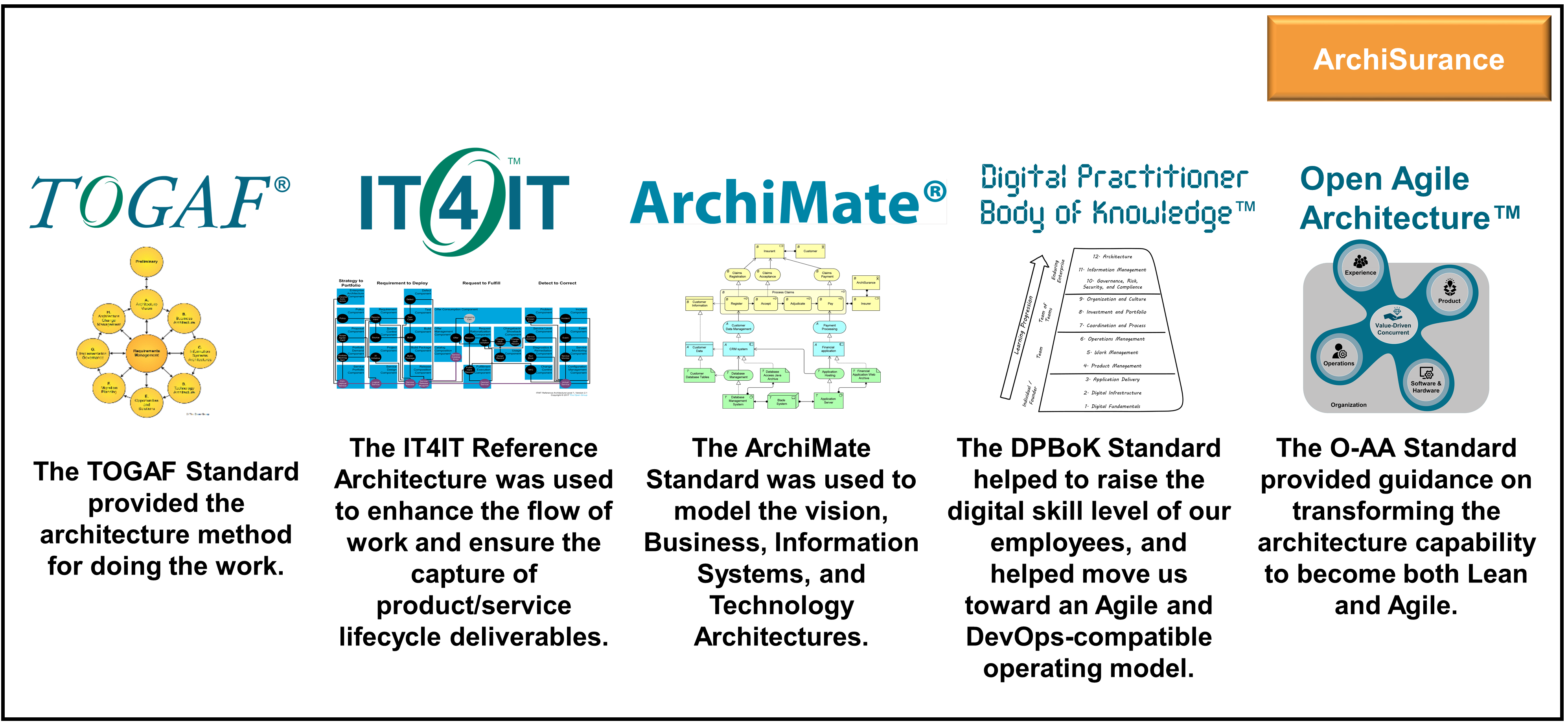
“We used the IT4IT Standard to guide us through the data flow automation of our deliverables. In our baseline state we had lots of disparate systems for keeping track of our architecture, initiatives, development, and service management deliverables. There was also a lack of communication between groups because the systems were built independently of each other. We were able to narrow the core systems down to four, and build integrations between each so that the information would flow from one system to the next. This eliminated lots of manual re-entry of data and reduced the cycle time of getting an Idea approved through funding down to a few days instead of taking up to six weeks, like it used to. This next slide (Data Objects) shows the data objects stored in each of the four systems. The data objects for the Digital Product Backbone are the thread that creates traceability from the portfolio to Operations. We hope to eventually have one centralized system, but for now the integrations are working well.”
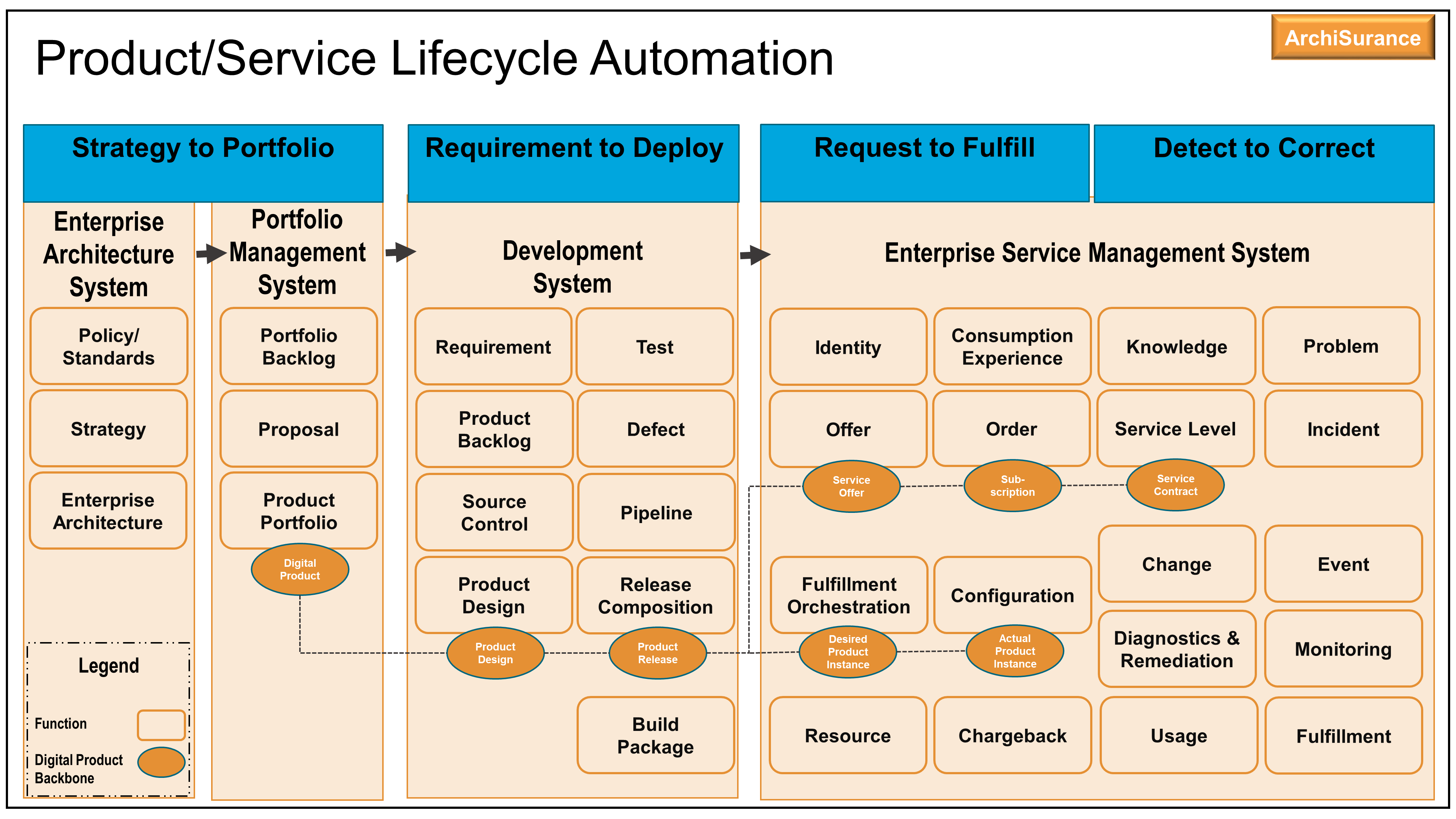
Beginning to shake off the jitters from being on the main stage, Kathleen carries on with more ease. “I would like to walk you through some of the key deliverables on this next slide (Key Deliverables). I cannot say enough about the work our Business Architects did to frame what we needed to do. As I mentioned before, we used The Open Group TOGAF Standard [19] to guide us, as well as the extremely helpful TOGAF® Series Guides. The Business Architects spent several weeks interviewing different types of stakeholder groups, gathering the pain points, concerns, ambitions, and dreams related to the current situation and understanding of their vision and objectives. The information obtained was used to characterize the baseline state and to create a capability heat map to ascertain our gaps with the target state. All of this was done in the context of an end-to-end value stream. The gaps led to opportunities and solutions that were prioritized, and, from that, we created our roadmap.
The result is four big accomplishments:
-
We completed application rationalization to simplify our environment.
-
We created a digital product pipeline that keeps work flowing and traceable from Strategy to Operations.
-
We deployed new technology in support of our digital products.
-
We established Agile governance methods to guide future digital product endeavors.
All together, these changes have helped to make us a digital company.”
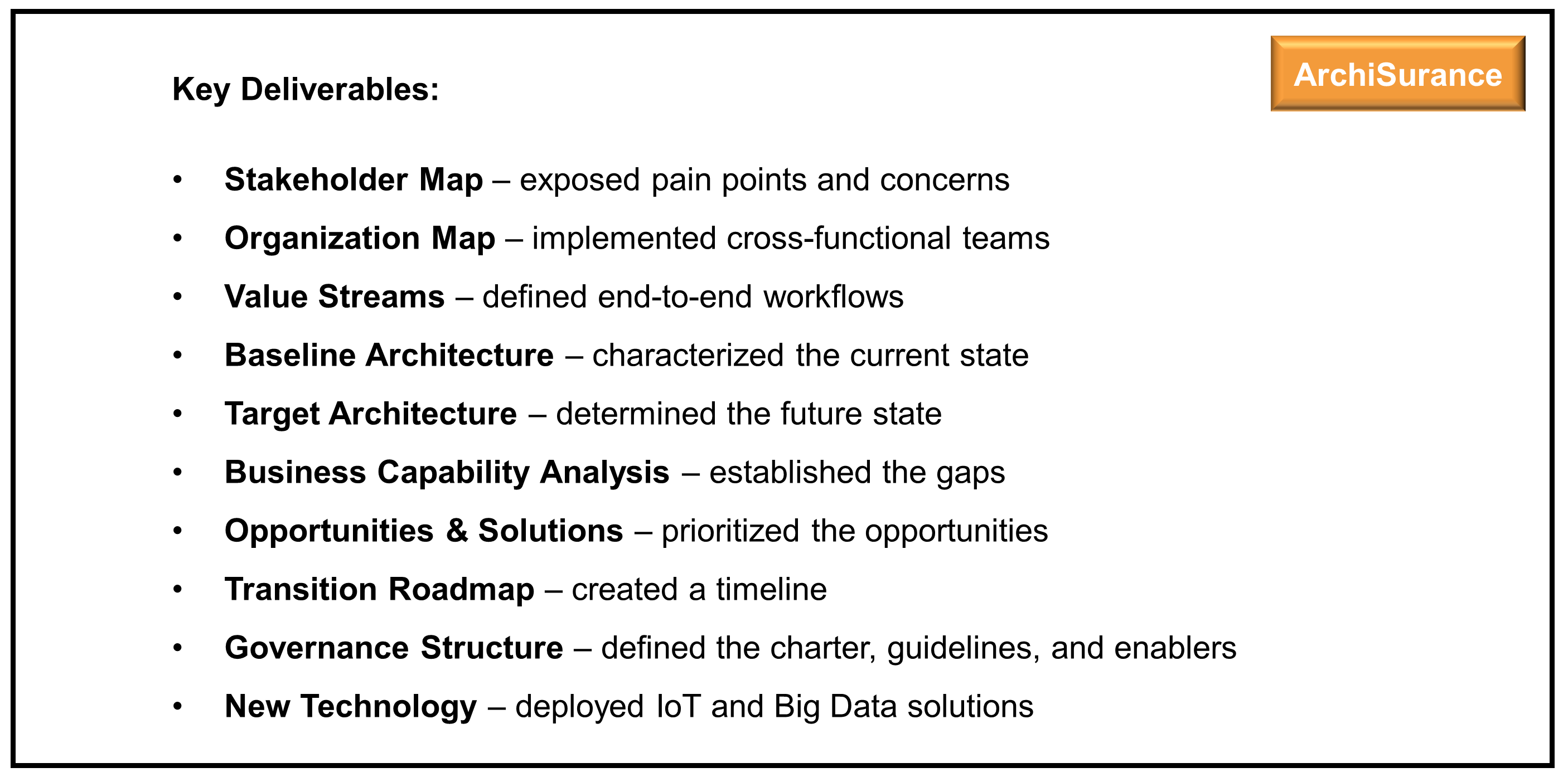
Kathleen pauses again to look at the audience. She smiles. “As I said at the beginning of my presentation, we owe a good measure of our success to The Open Group standards. They provided us with a map for our digital journey. Here, on my next slide (Successes and Lesson Learned), is a list of the successes and lessons learned.”
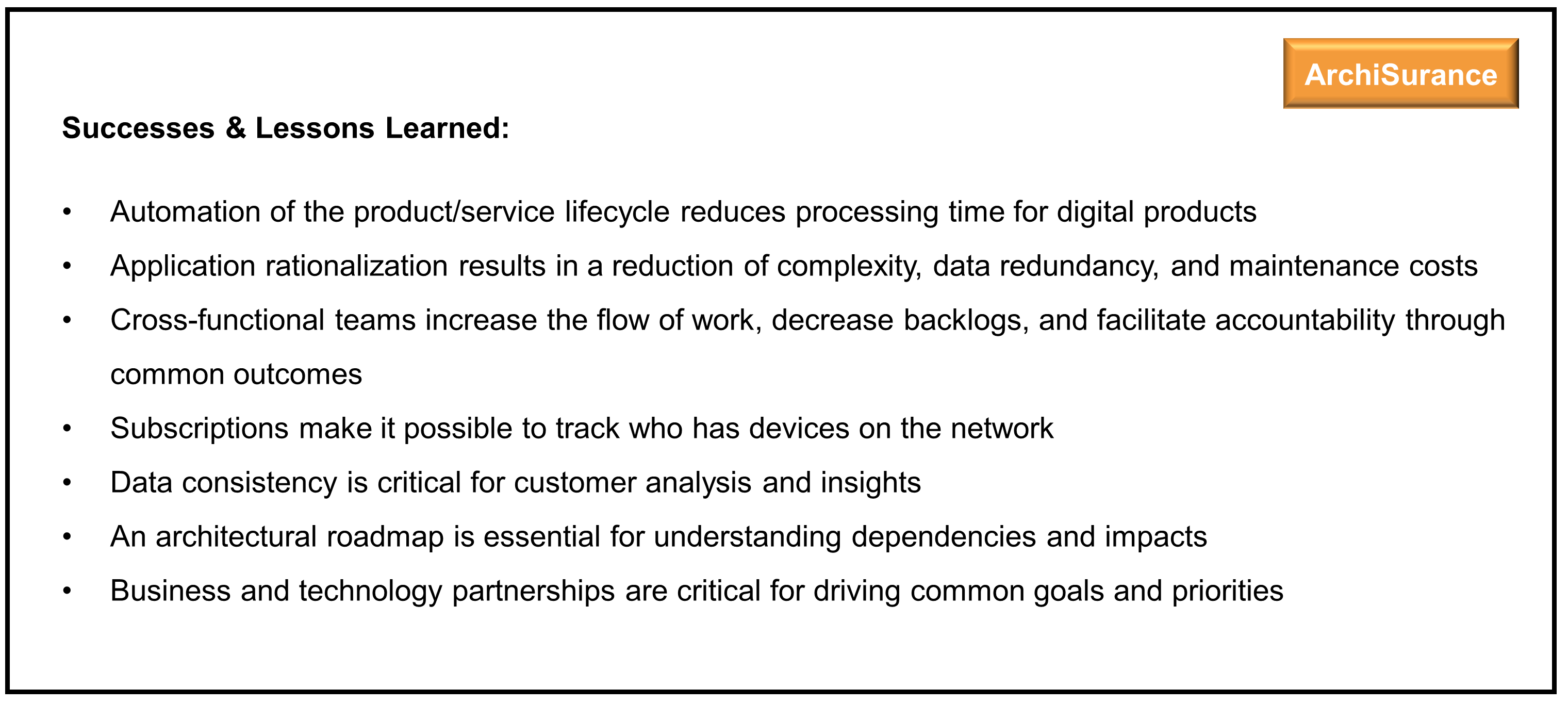
Kathleen gives the audience a few moments to read the slide. “The one thing I will mention here,” she says, “is that the biggest lesson was that there is an enormous amount of work that needs to be done in most organizations to become a digital enterprise and most of that work has nothing to do with technology. People and lines of communication are equally as important as the technology. Value streams and working end-to-end with cross-functional teams has been one of the keys to our success. I want to share our Digital Customer Intimacy roadmap with you, Digital Customer Intimacy Roadmap. It really shows the journey. We color-coded it so you can clearly see where we used the TOGAF Standard (in yellow) and the IT4IT Standard (in blue).” Kathleen pauses again to let the audience take in the details.
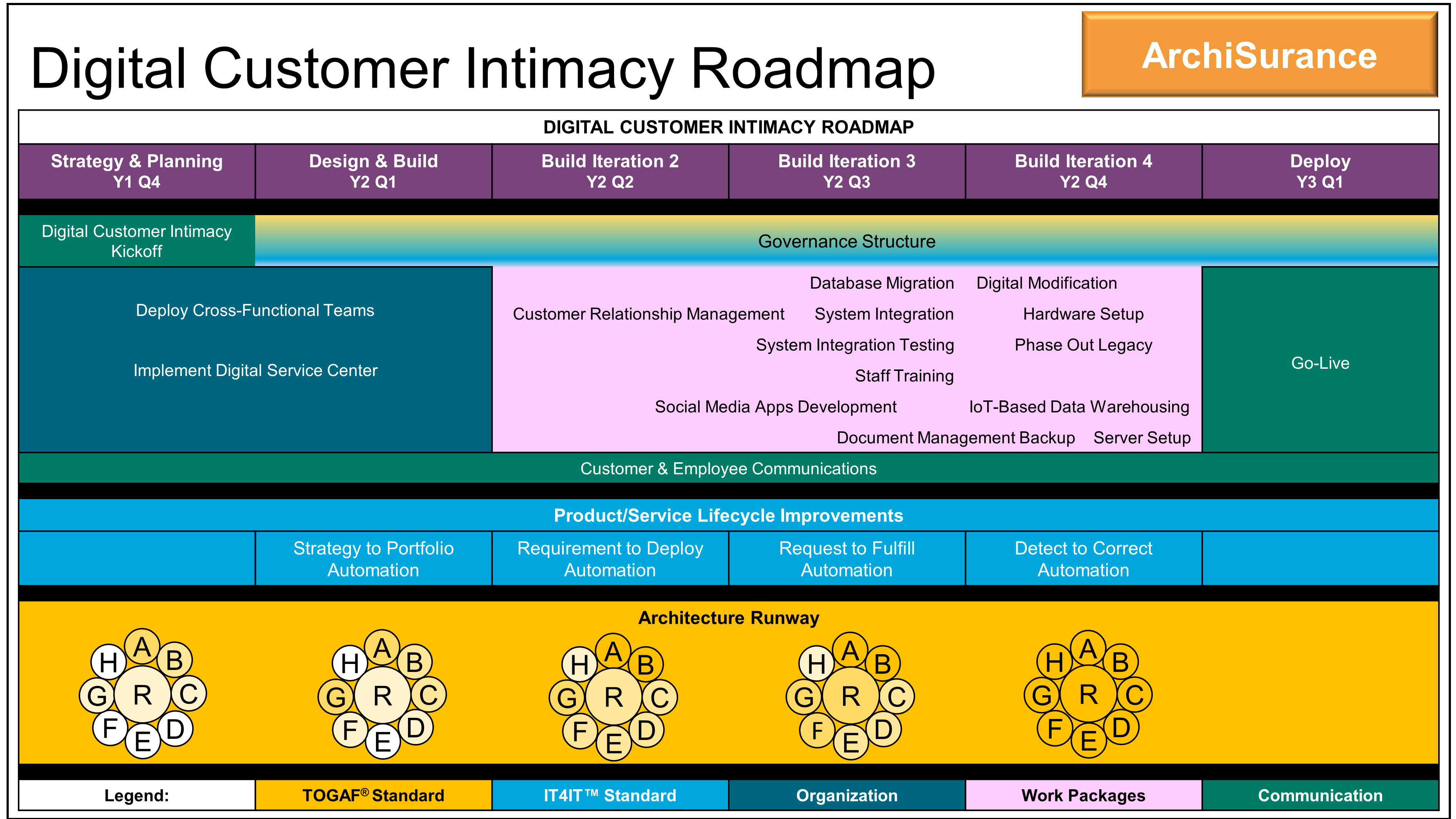
“We started strategic planning with the business in Q4 of last year. It was the first time IT had a seat at the table with the business. Previously IT developed their strategy, and the business developed theirs, and then there would be an attempt to align them. The strategy discussions together were so successful that IT kept being invited back and now it is second nature for IT and the business to work together. The best part about co-creating the strategy as a regular cadence is that the work outlined during strategy sessions automatically gets carried forward into DevSecOps because they have a seat. Also, when it is time to deploy solutions, the Operations group is ready because they have been involved in the strategy sessions and know what is coming down the pike.”
Kathleen looks up at the screen again. “So, you can see on the roadmap that the development of a governance structure was started early in the schedule. This was due to the agility we wanted to achieve with digital product development. We needed to have principles and guardrails established to keep us on track so the ingrained gating processes did not bog us down. If we were going to eliminate the restrictive gates, we needed to put forth new, more flexible guidelines.” Kathleen reached for the glass of water on the podium and took a quick sip.
“The TOGAF Standard gave us the methods for developing Architecture Runways very quickly for our build iterations and we established many building blocks and reference architectures that will help us with ongoing initiatives. The Business Architecture work that was done helped shape the vision and strategy for the development teams and only required minor modifications throughout build iterations. Governance and change management methods were firmed up early and modifications were made as needed during each iteration. We were also able to implement new guidelines for the architects that made it permissible for them to deliver only the level of granularity needed for each build iteration to speed up the development of Architecture Runways. We were steered by a reference from The Open Group that helps guide the core architecture needed for each iteration.” [1]
Kathleen is reassured to see that several members of the audience are nodding and one or two are even taking notes. She continues. “The IT4IT Standard for digital really helped us to build our product development tool chain. For example, the Strategy to Portfolio value stream laid out for us the data linkages required to achieve full traceability from a strategic theme to Enterprise Architecture, which forms the set of proposals that turn into Portfolio Backlog and Product Backlog. The same was achieved for Requirement to Deploy, Request to Fulfill, and Detect to Correct value streams, giving full traceability of the product lifecycle by integrating our primary tracking tools.”
She clicked to reveal the next slide. “The TOGAF ADM as a Big Bang shows the way we used the TOGAF ADM in the past, where we would create all of the artifacts before starting any of the development work. With Agile and the need to build in increments to add value iteratively, we have adjusted to only build enough Architecture Runway for each MVP. This approach adds value with each release of a product and promotes continuous improvement.”
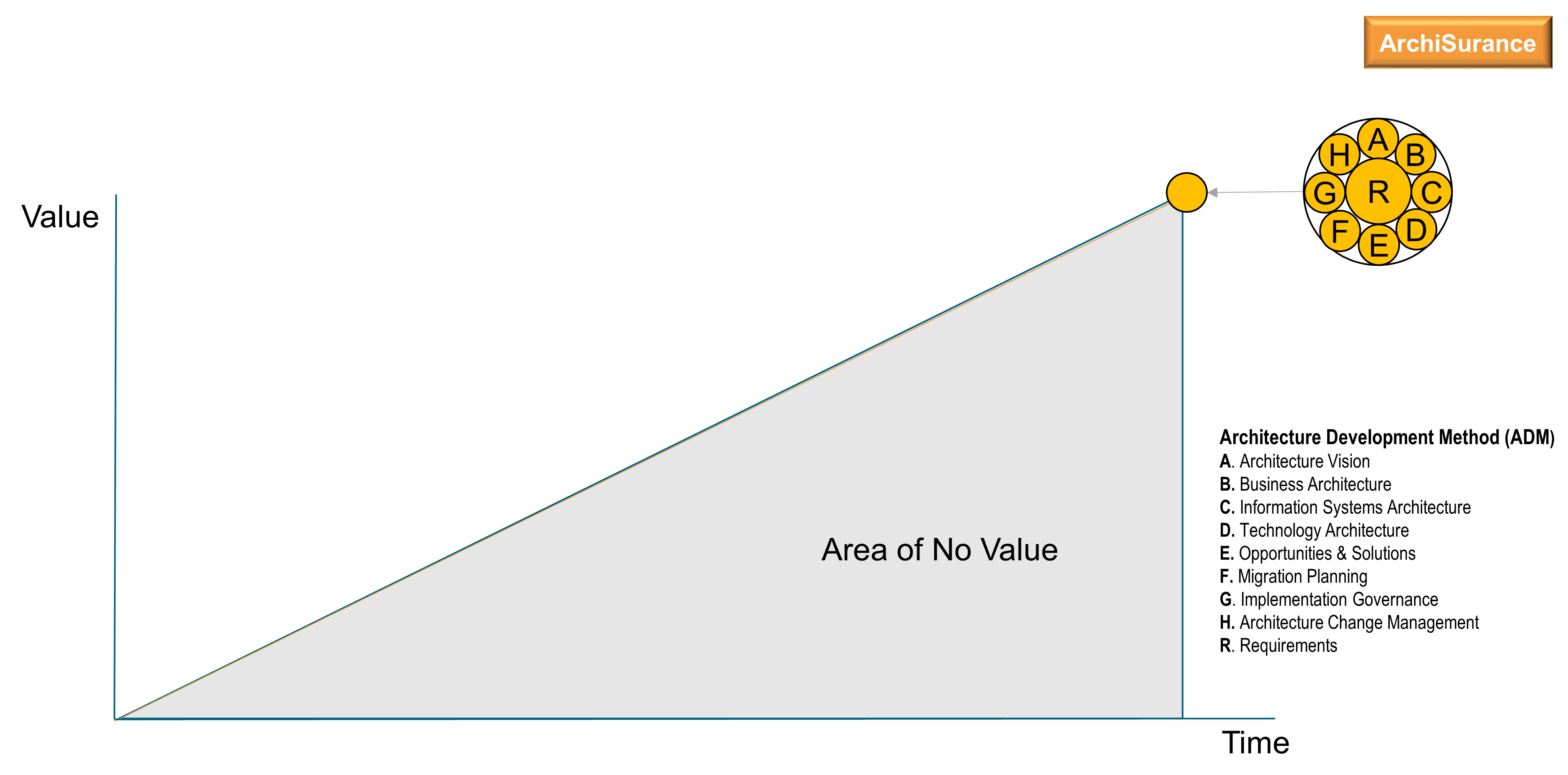
Kathleen clicked again. “Developing the TOGAF ADM Iteratively shows the core architecture we developed for each iteration in more detail and how the level of completion increases as the shade becomes darker. For example, in the first iteration, the future vision is the most important element to establish with stakeholders. It becomes the guiding light for all of the teams. Business Architecture is shaded a bit lighter and it also needs to be started early to establish the baseline state. The Business Architecture will continue to be refined in future iterations as gaps are uncovered in getting to the target state defined by the vision. Requirements and governance are lighter than the Business Architecture in the early iterations, and need to be started early as well, but may not be as well formulated until after development begins and an MVP release or two have been completed. The DPBoK Standard endorses this style of incremental architecture, stating that “large system changes are inherently risky, and any intervention into a complex system is better undertaken as a series of smaller, incremental changes, with frequent monitoring and assessment” [1].”
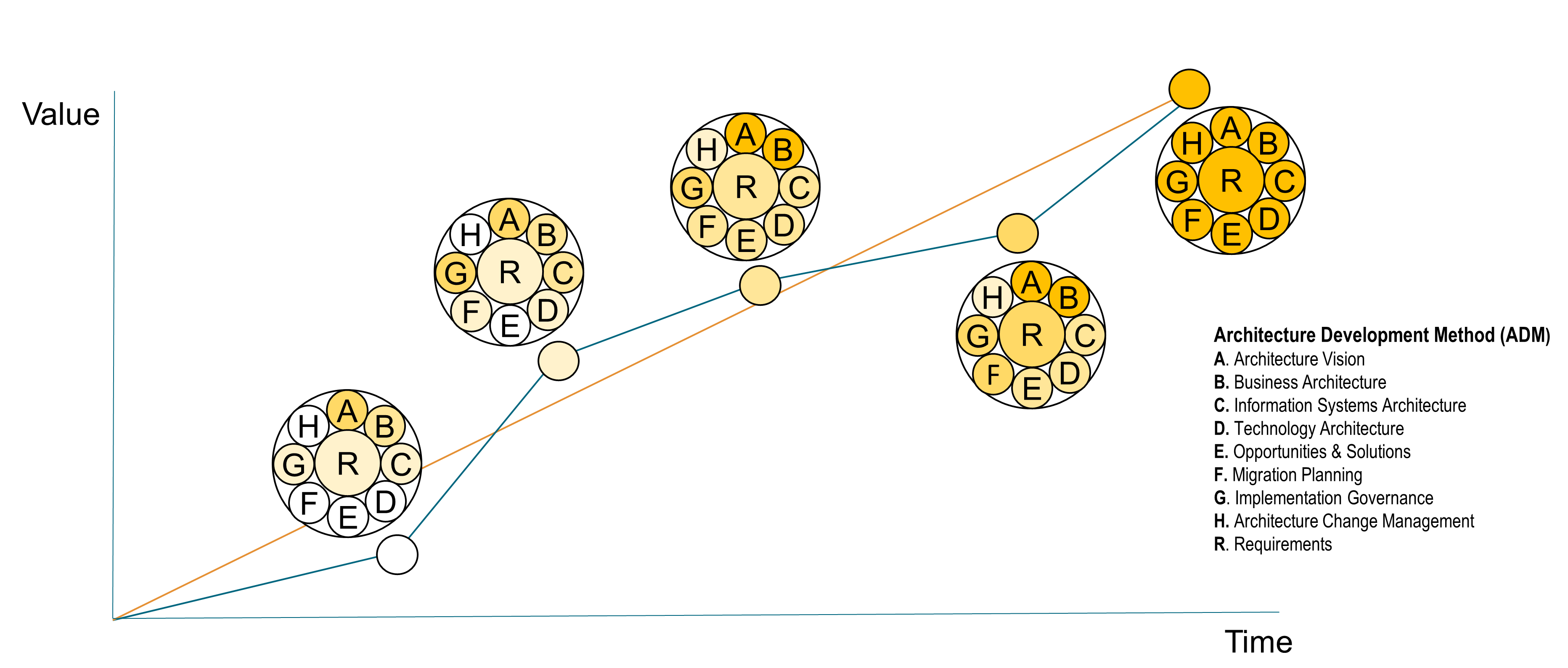
Kathleen draws a deep breath and begins to bring her presentation to a close.
“Well, that was our Digital Transformation journey to date. As I have described, not only did we deploy digital capabilities, but we also changed our culture and way of working from silos to team structures across value streams. When we did that, we had to change the way money was being allocated to the functional groups to a shared value stream funding model. Another big change was to disband our traditional project methodology and gating to get to a continuous product lifecycle model. All these transformations make us Agile and provide the velocity to take on digital product implementations as a way of doing business. The biggest lift was getting our business working together on the most important objectives and the traceability of work products from Strategy to Operations.”
As Kathleen finishes, Steve comes back up to the stage and invites her to take a seat. “Great, thank you. Quite a journey! And congratulations on where you’ve got to. We have some great questions from the audience for you. The first question: how did you get your leadership team to buy into organizing teams across value streams?”
“Well, that was one of the more difficult culture changes we made because we wanted to break down the political barriers between the functional groups, but did not want to completely tear them down. The functional groups are the pillars that hold up the structure of our organization by maintaining the policies and procedures for a specific area, and the value streams run across them. Most of the silo thinking and barriers were due to established goal structures. Each functional group was responsible for completing their own goals within their own budget, which inhibited working together toward common outcomes. Simultaneously, this suppressed cross-functional thinking because functional silos were only accountable for their piece of the product, which created a bottleneck effect; work stuck in queues waiting for each functional group to pass it along to the next. This silo way of thinking also resulted in many duplicate tools being developed to store the same type of product lifecycle information. It took quite a while to get leadership to see the value of working in teams with a shared funding model[2] across value streams toward common goals, but it has been tried and proven now with several of our value stream team implementations. We do it one value stream at a time and the benefits speak for themselves as the flow of work increases when teams have the same outcomes they are working to achieve. We also set up an accountability framework where people are rewarded for working together versus the silo way of working where people were rewarded for staying within their own boundaries and scope.”
“Thanks, Kathleen,” says Steve, “for answering that especially important question concerning Digital Transformation. I don’t think we can say enough about the importance of teaming across value streams to work on common outcomes, which inevitably increases the visibility and flow of work. Thank you. Let me move on to the next question. I believe you had to deal with an issue caused by unexpected changes in the system? Tell us about that.”
“Yes, we had issues with the operation of the new digital products platform. Our customers began to experience problems accessing their own information, and new requests just weren’t making it through. To make it worse, the Operations team could not get anything out of their monitoring systems, so they were logging in manually to individual servers without access to any centralized information. I was away on holiday – just about to go through airport security – and my colleague, Nick, had set up two incident resolution swarms, one for the product issue and one for the monitoring issue. He rang me just as I was at the airport. We quickly went through all deployments done by the teams in the previous 48 hours, and started to look for changes that must have taken place outside the automated approach. Then it hit us! The Security team had recently released a new version of their security platform. This new system had its own AI functionality and automatically began to apply the highest level of security to identified mission-critical systems, including any new monitoring systems – which the Enterprise Architecture team had not been aware of. So, we contacted the Security team and brought them into the incident swarm. The problem was soon solved. And after the incident we looked at the IT4IT value streams again. It seemed that the “Detect to Correct” value stream would help us to understand the current state of production, to enable a comparison between the Actual Product Instance and the Desired Product Instance to allow the discovery of something implemented outside the approval process, and also identify the potential impact of changes, by making sure that a register of all changes is maintained in a central repository. We can now track transition states and assess the target state, which gives us much better visibility into the Architecture Change Management.”
“Thanks, Kathleen. So, you’ve clearly got everything set up going forward, but as with any company out there, you must have been using those monolithic systems which are too big to change and at the same time create a blocker for transformation. How did you solve the issue of these monolithic and often legacy systems?”
“Oh, no, not the B.L.O.S.!” Kathleen groans. “Oh, sorry Steve. I mean the Prolongation Application! The B.L.O.S. was not its official name – but that’s what it became known as: the Big Ludicrous Old System! This was a system marked for replacement for many years because it became more and more of a liability. It simply was not possible to scale any further. Unfortunately, we just failed at every attempt of replacement! It became a collective headache for us all. Every time the team tried to deliver a replacement system, the test cycle found something else the current system was doing that nobody could have predicted. And it seemed that everybody needed to wait on this replacement system, but everyone could see it was not happening. Poor old Hans Pickle! He had the task of replacing this legacy system. It was connected to so many processes it was just too big to fail. Every attempt to dismantle the application failed to deliver. It just became a liability. Our consultant, Amy Lee, asked whether our big-bang approach, to replace it all at once, was really the best way to go to. But we couldn’t see any other option. As Ben – Ben Cohan, one of our Business Analysts – pointed out, all the data he needed was available in the application – it was just all over the place! There was no API in place to extract data using a query. I realized that regulations had forced a backup of data to be created for all critical systems, for business continuity. So, it was just a case of checking with the Risk Management team to see if that data contained the information Ben needed, creating a quick fix. This fix allowed us to develop solutions for other integrations as well, removing the strain on the B.L.O.S.”
“But,” says Steve, “That did not solve the real problem of replacing the B.L.O.S.?”
“No. As Amy pointed out, it’s not always possible, or even the best approach, to try to replace something that big using a big-bang. So, we did our research and found a concept called “strangler pattern” referenced in the O-AA Standard. It basically means that sometimes you have to create room to breathe by slowly strangling something. It allowed us to create space to evolve a replacement behind an API, while bypassing the B.L.O.S. and keeping the data in sync.”
“Well, that sounds like a good result for such an issue. We have time for one more question: if you had anything you would do over or better, what would it be?”
Kathleen responds very quickly. “Getting Architecture Runways in place faster is something I would focus on more. I did not really realize how much the architects and strategists need to work with the Business Relationship, Portfolio, and DevSecOps teams to keep all the work products in sync continuously in our Agile world. I did not recognize that the architects needed to be at every team synchronization meeting until it was almost too late. They need to be involved to keep the teams in line with architecture quality attributes, principles, and standards. Strategists, Business Relationship Managers, and Portfolio Managers needed to be there too, so we could adjust as needed and stay in sync with the business. Strategy is no longer a once every three-to-five-year conversation. The discussion needs to be continuous.”
“Thanks so much for being here today, Kathleen. It means a lot to us here at The Open Group to hear about real successes at our members’ companies using the standards that have been developed by the consortium. Also, thank you Kathleen for your company’s contributions to the TOGAF and IT4IT Standards.” Steve turns to the audience. “We will see you all back here in the auditorium after a 15-minute coffee break.” The audience claps for several moments and then begins to wander into the hall for the break. Several members come up to Kathleen to share their own experiences and ask additional questions.
At the end of the conference Kathleen leaves feeling accomplished, not only with her internal work at ArchiSurance toward a successful Digital Transformation, but also for the external work her team had contributed to the architecture discipline through The Open Group.